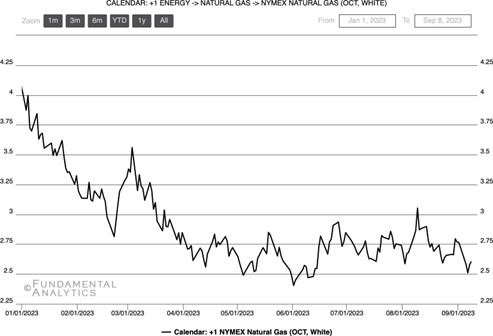Dr. Ken Rietz
September 13, 2023
The natural gas space has been something of a circus lately, with a number of different forces pulling prices in different directions. Accordingly, the prices have jumped up and down more than usual. This commentary will look at three of those factors. First, let’s look at the recent prices for natural gas October 2023 futures on the NYMEX Exchange.
Figure 1: Natural gas futures (Contract 1) in dollars per million BTU, NYMEX Exchange delivered at Henry Hub, LA

Underneath all of this price movement is the US dollar. The dollar has been strengthening since July 16, 2023, nearly uniformly. This makes natural gas from the US more expensive for other countries. But since the US is the foremost producer and exporter of natural gas, this pulls up the price of natural gas globally. Contrary to intuition, the price of natural gas forwards plummeted 30 cents from August 31 to September 6. That drop, however, is unlikely to continue, since summer 2024 forwards prices are down only 9 cents.
The on-and-off character of labor strikes on Chevron LNG plants in Australia (currently on) played havoc with natural gas prices, particularly in Europe. The loss of Russian natural gas was not as catastrophic as it might have been for Europe, due to a mild winter (and in some countries, lots of sweaters), and supplies of LNG are a sensitive issue there. Potentially, a great deal of help could come from Mexico, which is on the verge of exporting LNG, using the abundant US natural gas from the Permian basin. Most of that gas will likely go west to Asian markets, but some ports face east.
A new wild card in the natural gas arena is the movement to decarbonize. Although natural gas still produces carbon dioxide when burned, the amount is smaller than other fossil fuels. The EIA gives the amount of carbon dioxide produced by enough fuel to produce one million BTU of heat.

In 2019, the US electric power sector produced 1,724 million metric tons (MMmt) of CO2, 32% less than the 2,544 MMmt produced in 2005, according to the EIA. This is the result of reducing coal producing 50% of the electricity used in 2005 to 23% in 2019, and natural gas producing 19% of the electricity used in 2005 to 38% in 2019. This is a powerful argument for increased use of natural gas.